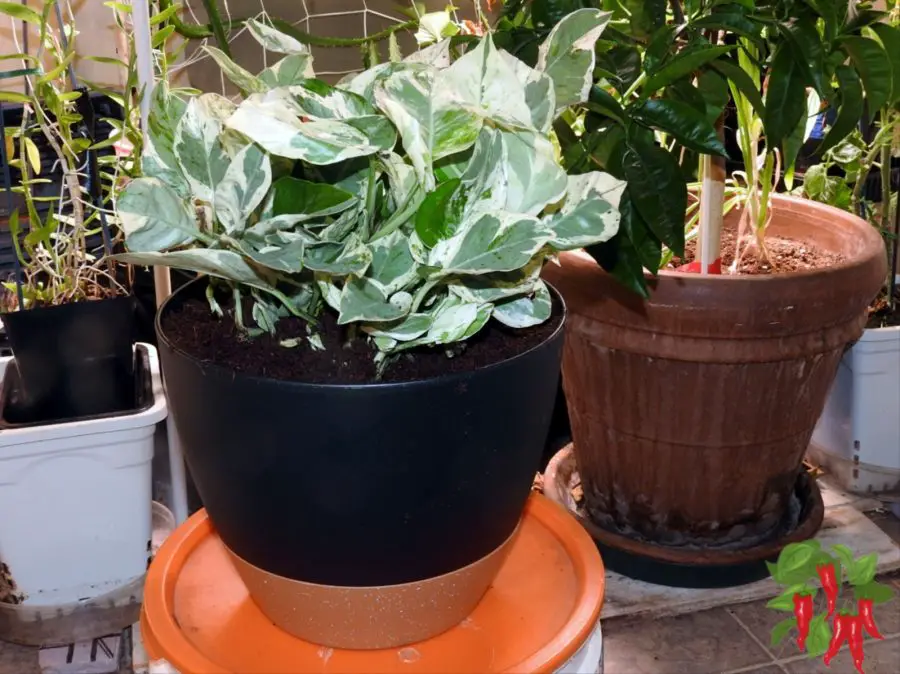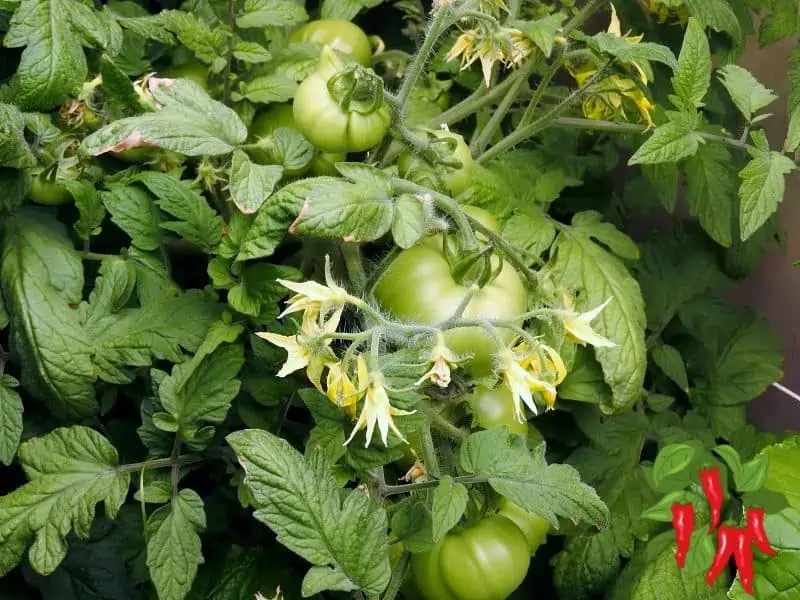This post may contain affiliate links. If you buy something from one of our links we may earn a commission. Thanks

Hey there, plant pals! Let’s chat about N’Joy Pothos care. These cool little plants are great for sprucing up your indoor space. I’ll show you how to keep them happy and healthy without any fuss.
N’Joy Pothos care can be a bit tricky if you’re new to houseplants. These beautiful vines with their white and green leaves need the right balance of light, water, and care to thrive. But don’t worry! With a few simple tips, you’ll have your N’Joy Pothos looking lush and healthy in no time.
N’Joy Pothos Care Key Takeaways
- Caring for N’Joy Pothos involves:
- Providing bright, indirect light
- Watering when the top inch of soil feels dry.
- Using well-draining potting mix.
- Keep temperatures between 65-85°F.
- Prune regularly to maintain shape.
- Fertilize monthly during the growing season.
- Consider training Pothos to climb for larger leaves and to save floor space.
How To Grow N’Joy Pothos Video
Hey everyone! Today in this video we’re talking about the N’Joy Pothos, a beautiful variegated plant that’s similar to but distinct from the Pearls and Jade Pothos. I’ll show you how to repot it in a self-watering planter and share some tips on growing and training this versatile houseplant. Whether you want it trailing, climbing, or as a regular potted plant, I’ve got you covered. Let’s dive in and keep it green!
N’Joy Pothos Care: Growing a Happy, Healthy Plant
 Pothos (‘N Joy’) – 6” from California Tropicals
Pothos (‘N Joy’) – 6” from California Tropicals
N’Joy Pothos are pretty chill plants. They don’t need much to thrive, but a little TLC goes a long way. Let’s break down what they need to stay green and gorgeous.
What is a Pothos
Pothos or Epipremnum aureum is a genus of many different Pothos varieties such as the Manjula Pothos and the Snow Queen Pothos and N’Joy Pothos is a cultivar of the Marble Queen Pothos.
Pothos is a genus of flowering plants in the family Araceae (tribe Potheae). It is native to China, the Indian Subcontinent, Australia, New Guinea, Southeast Asia, and various islands of the Pacific and Indian Oceans.
The common houseplant Epipremnum aureum, also known as “pothos”, was once classified under the genus Pothos. https://en.wikipedia.org/wiki/Pothos_(plant)
| Feature | Description |
|---|---|
| Scientific Name | Epipremnum aureum ‘N’Joy’ |
| Popular Name | N’Joy Pothos |
| Plant Family | Araceae |
| Growth Habit | Climbing vine, Perennial |
| Maximum Length | Approximately 3 meters (10 feet) |
| Ideal Light | Bright indirect |
| Preferred Soil | Well-draining, slightly moist |
| Optimal Soil pH | 5.5 – 6.5 (Slightly acidic) |
| Flowering Season | Rarely flowers indoors |
| Leaf Colors | Green with white variegation |
| USDA Zones | 10-12 (Outdoor growth) |
| Origin | Cultivated variety, parent species from Southeast Asia |
| Pet Safety | Not safe for cats and dogs |
N’joy Pothos vs Pearls and Jade: Spot the Difference!
Hey plant lovers! Let’s talk about two pothos varieties that often get mixed up: N’Joy and Pearls and Jade. They might look similar at first glance, but there are some cool differences. Let’s break it down!
Leaf Patterns
- N’Joy: Has crisp, clean variegation. The white parts are usually larger and more distinct.
- Pearls and Jade: Shows more speckled or marbled variegation. You’ll see green speckles in the white areas.
Growth Rate
- N’Joy: Tends to be a slower grower. It takes its time, but that means less pruning for you!
- Pearls and Jade: Usually grows a bit faster. It’s eager to show off those pretty leaves.
Leaf Size
- N’Joy: Often has slightly smaller leaves.
- Pearls and Jade: Typically sports somewhat larger leaves.
Variegation Stability
- N’Joy: Holds its variegation pattern pretty well, even in lower light.
- Pearls and Jade: Might lose some variegation in low light conditions.
Care Needs
Both plants have similar care needs, but there are slight differences:
- N’Joy: Can tolerate slightly lower light, but still prefers bright, indirect light.
- Pearls and Jade: Needs a bit more light to maintain its intricate variegation.
Which One to Choose?
Honestly, they’re both awesome! Here’s a quick guide:
– Go for N’Joy if you want:
* A slower-growing plant
* Crisper, more defined variegation
* A plant that’s a bit more forgiving in lower light
– Pick Pearls and Jade if you prefer:
* A faster-growing vine
* More intricate, speckled variegation
* Slightly larger leaves
 Pothos Plant (Pearls & Jade) – Easy to Care for
Pothos Plant (Pearls & Jade) – Easy to Care for
Remember, both these pothos varieties are beautiful and easy to care for. The best choice is the one that makes you smile when you look at it!
N’Joy Pothos Benefits: More Than Just a Pretty Face
Your N’Joy Pothos isn’t just a looker – it’s got some cool tricks up its leaves!
First off, it’s a natural air cleaner. Yep, this little plant helps filter out some nasty stuff from your indoor air, like formaldehyde and benzene. It’s like having a tiny, leafy air purifier!
Plus, having plants around can make you feel happier and more relaxed. It’s true! Studies show that indoor plants can help reduce stress and boost your mood.
And let’s not forget how easy these guys are to grow. You don’t need a green thumb to keep an N’Joy Pothos happy, which means less stress for you and more green in your space.
So whether you’re a plant newbie or a seasoned pro, a N’Joy Pothos is a win-win for your home and your wellbeing.
N Joy Pothos Light Requirements: What N’Joy Pothos Needs
These guys love bright, indirect light. Think of a spot that’s sunny, but not in direct sunlight.
A few feet away from a window is perfect. If the leaves start to lose their white patches, they might need more light.
But watch out for brown spots – that’s a sign of too much sun.
Water: Keeping Your Plant Just Moist Enough
N’Joy Pothos like their soil to dry out a bit between waterings. Stick your finger about an inch into the soil. If it feels dry, it’s time to water.
Don’t go overboard, though. These plants hate sitting in water. Make sure your pot has drainage holes to let excess water escape.
Soil: The Right Mix for Happy Roots
Use a well-draining potting mix for your N’Joy Pothos. You can buy one from a garden store or make your own.
I prefer a coco coir mix with added perlite to help with drainage. If your plant outgrows its pot, it’s time to repot. Spring is the best time for this.
Temperature and Humidity: Comfy Conditions
N’Joy Pothos like it warm, between 65-85°F. They’re not fans of cold drafts, so keep them away from air conditioners or drafty windows.
They also like a bit of humidity. If your home is dry, you can mist your plant or put a small tray of water nearby.
Feeding Your N’Joy Pothos
These plants aren’t big eaters, but they do like a snack now and then. Use a balanced, water-soluble fertilizer once a month during spring and summer. In fall and winter, you can skip the feeding – your plant will be taking it easy.
Pruning and Shaping: Keeping It Tidy
N’Joy Pothos can get a bit wild if left alone. Trim them back when they get too long. This will help them stay bushy. You can use the cuttings to make new plants – just pop them in water until they grow roots, then plant them in soil.
Training Your N’Joy Pothos to Climb
Hey, want to see something cool? Your N’Joy Pothos can do more than just hang around.
With a little help, it can climb up instead of out. This trick can give you bigger leaves and save floor space. Let’s check it out!
Why Train Your Pothos to Climb?
- Bigger Leaves: When pothos climb, their leaves can grow way bigger. It’s like they’re showing off!
- Save Space: Instead of sprawling across your floor, your plant will grow up. It’s great if you’re short on space.
- Natural Look: In the wild, pothos love to climb trees. Letting them climb indoors mimics their natural habit.
How to Train Your N’Joy Pothos
1. Pick Your Support: You’ve got options here. Try a moss pole, a trellis, or even a plain old wooden stake. Just make sure it’s sturdy.
2. Plant Prep: If your pothos is already in a pot, great! If not, plant it in a container with good drainage.
3. Add the Support: Stick your chosen support into the pot. Be careful not to damage the roots.
4. Guide the Vines: Gently wrap the vines around the support. Use soft plant ties or twine to secure them.
5. Keep At It: As your pothos grows, keep guiding the new growth up the support.
6. Be Patient: It might take a while, but soon your pothos will get the hang of it and start climbing on its own.
Tips for Success
- Mist the support if you’re using a moss pole. Pothos love to sink their aerial roots into moist moss.
- Don’t tie the vines too tight. You want to guide them, not strangle them.
- Keep an eye out for new growth and guide it to the support.
Remember, every plant is different. Your N’Joy Pothos might take a little time to adjust to climbing.
But stick with it, and soon you’ll have a beautiful, upward-growing plant that’s the talk of your indoor garden!
N’Joy Pothos propagation:
Multiplying Your N’Joy Pothos: Easy Propagation Tips
Want to know a cool trick? You can make more N’Joy Pothos plants from the one you already have. It’s called propagation, and it’s super easy. Let’s walk through it together.
Why Propagate Your N’Joy Pothos?
- Make new plants for free
- Share with friends (they make great gifts!)
- Fill out your existing plant
- It’s fun and rewarding!
Water Propagation Method
1. Find a healthy stem: Look for a stem with at least 2-3 leaves and a node (that’s the bumpy part where leaves grow from).
2. Make the cut: Use clean, sharp scissors to cut just below a node. Your cutting should be about 4-6 inches long.
3. Remove lower leaves: Take off the bottom leaf or two, leaving the node exposed.
4. Pop it in water: Place your cutting in a clear glass of water. Make sure the node is submerged but keep the leaves above water.
5. Find a good spot: Put your glass in a warm place with bright, indirect light.
6. Wait and watch: In a few weeks, you’ll see roots growing from the node. How cool is that?
7. Planting time: Once the roots are about an inch long, you can plant your cutting in soil.
Soil Propagation Method
If you prefer, you can skip the water step and plant your cutting directly in soil:
1. Prepare a small pot: Fill it with a well-draining potting mix.
2. Plant your cutting: Make a hole and gently place the cutting in, burying the node.
3. Keep it moist: Water lightly and keep the soil slightly damp (but not soggy).
4. Be patient: It might take a bit longer to see growth, but your cutting should root in a few weeks.
Pro Tips for Successful Propagation
- Use clean tools to avoid spreading diseases
- Change the water every few days if you’re using the water method
- Be patient – some cuttings take longer than others to root
- Don’t let cuttings get too big in water – they can have trouble adjusting to soil
There you have it! With these simple steps, you’ll be a propagation pro in no time. Before you know it, you’ll have N’Joy Pothos plants all over your house. Happy propagating!
Growing N’Joy Pothos in Water and Aquariums: A Splash of Green
Guess what? Your N’Joy Pothos doesn’t always need soil to thrive. These versatile plants can grow happily in water alone, making them perfect for that empty vase or even your fish tank!
To grow in water, just pop a cutting in a vase and change the water weekly. It’ll grow roots and keep on trucking indefinitely.
Now, if you’ve got an aquarium, you’re in for a treat. N’Joy Pothos can grow with their roots in the water and leaves above, creating a beautiful, natural look.
Plus, they help keep your tank clean by soaking up nitrates – it’s like having a living filter! Just make sure only the roots are submerged, and your fish can’t nibble on the leaves (remember, pothos are toxic if eaten).
Whether in a simple glass of water or as part of your aquascape, water-grown N’Joy Pothos bring a whole new dimension to your plant game. Cool, huh?
Common Problems and Quick Fixes
Even with the best care, your N’Joy Pothos might run into a few issues. But don’t worry! Most problems are easy to spot and fix if you catch them early. Let’s go over some common problems and how to solve them.
Yellowing Leaves
If your pothos has yellow leaves, it’s usually because of too much water. The fix is simple:
- Cut back on watering
- Make sure your pot has good drainage
- Only water when the top inch of soil feels dry
Brown Leaf Tips
Brown tips often mean your plant needs more humidity. Try these tricks:
- Mist your plant regularly
- Put a pebble tray with water near your plant
- Group plants together to create a mini humid zone
Pest Problems
Tiny bugs can be a pain, but you can deal with them:
Spider Mites:
- Look for tiny webs on leaves
- Wipe leaves with a damp cloth
- Spray with neem oil or insecticidal soap
Mealybugs:
- Check for white, cottony spots on stems and leaves
- Dab them with a cotton swab dipped in rubbing alcohol
- Treat the whole plant with neem oil
Scale Insects:
- Look for small, brown bumps on stems and leaves
- Scrape them off gently with a soft brush
- Apply horticultural oil to smother any remaining bugs
Fungus Gnats:
- These tiny flies live in moist soil
- Let the soil dry out more between waterings
- Use sticky traps to catch adult gnats
Disease Management
N’Joy Pothos are pretty tough, but they can get sick sometimes:
Root Rot:
- Caused by overwatering
- Remove the plant from its pot and check the roots
- Cut away any soft, brown roots
- Repot in fresh, well-draining soil
Leaf Spot:
- Look for brown or black spots on leaves
- Remove affected leaves
- Avoid getting water on the leaves when watering
- Improve air circulation around your plant
Preventing Problems
The best way to deal with problems is to stop them before they start:
- Don’t overwater
- Give your plant plenty of indirect light
- Clean the leaves regularly to prevent pest buildup
- Check your plant often for any signs of trouble
Remember, a healthy plant is better at fighting off pests and diseases. By giving your N’Joy Pothos the right care, you’ll help it stay strong and beautiful. And if you do run into trouble, now you know how to fix it!
Fun Facts About N’Joy Pothos
Did you know N’Joy Pothos is a type of variegated pothos? It was discovered in 2002 and people loved its white and green leaves. You can grow it in a hanging basket or train it to climb up a trellis or pole.
FAQ: Quick Answers to Your N’Joy Pothos Questions
Got Questions? We’ve Got Answers! Caring for your N’Joy Pothos doesn’t have to be complicated.
But I bet you’ve still got a few questions buzzing around in your head. Don’t worry, that’s totally normal!
I’ve rounded up some of the most common questions I get about N’Joy Pothos care. Let’s dive in and clear up any confusion you might have. Remember, there’s no such thing as a silly question when it comes to plant care!
Q: How often should I water my N’Joy Pothos?
A: Usually once a week, but check the soil first.
Q: Can I grow N’Joy Pothos in water?
A: Yep! Change the water every week or two.
Q: Is N’Joy Pothos safe for pets?
A: Nope, it’s toxic if eaten. Keep it out of reach of curious pets.
Q: How fast does N’Joy Pothos grow?
A: It’s a slow grower compared to other pothos types.
Q: Can I put my N’Joy Pothos outside?
A: Sure, but only when it’s warm. Bring it in if temps drop below 50°F.
That’s it! A simple guide to keep your N’Joy Pothos thriving. With a little care, your plant will look great in no time. Happy growing!
N’Joy Pothos Care Conclusion
Wrapping Up N’Joy Pothos Care
Now that you know the basics of N’Joy Pothos care, you’re all set to keep your plant happy and healthy.
Remember, these plants are pretty easy-going, but they do have a few key needs. Let’s recap:
Light and Water Needs
Your N’Joy Pothos likes bright, indirect light and doesn’t want to sit in wet soil. Keep an eye on these two things, and you’ll be off to a great start.
Soil and Fertilizer
Use a well-draining potting mix and give your plant a little fertilizer during the growing season. This will help keep those beautiful leaves looking their best.
Pruning and Propagation
Don’t be afraid to give your plant a trim now and then. It’ll help keep it bushy and full. Plus, you can use those cuttings to make new plants!
Troubleshooting Common Issues
If you notice any yellowing leaves or pests, don’t panic. Most problems are easy to fix with a little care and attention.
Key Takeaways:
- Provide bright, indirect light
- Water when the top inch of soil is dry
- Use well-draining potting mix
- Keep temperatures between 65-85°F
- Prune regularly for bushier growth
- Fertilize monthly during the growing season
- Watch for and address any pest issues promptly
Remember, every plant is unique, so don’t be afraid to adjust your care routine as needed. With a little patience and love, your N’Joy Pothos will be thriving in no time!
Read more: Indoor Apartment Gardening: 15 Point Comprehensive Guide
Visit my Amazon Influencer Page for videos and gardening products Grow Your Own Garden







